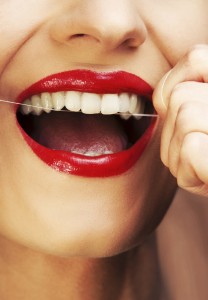 Flossing daily eliminates bacteria-laden plaque between teeth, around crowns, implants and other restorations and at the gum-line, too. This essential oral health tool works best according to guidelines taught by Renee Corbitt, Fort Worth, TX general dentist and her professional team.
Flossing daily eliminates bacteria-laden plaque between teeth, around crowns, implants and other restorations and at the gum-line, too. This essential oral health tool works best according to guidelines taught by Renee Corbitt, Fort Worth, TX general dentist and her professional team.
The American Dental Association says that kids and adults of all ages should floss between their teeth to keep tooth enamel strong and gums free of infection. Dr. Renee Corbitt, Fort Worth, TX dentist, takes time to teach her patients the basics of good dental hygiene, including daily flossing.
What’s the best way to floss your teeth?
Everyone should brush their teeth twice a day for at least 2 minutes. Before or after one of these sessions, floss your teeth. Take your time with it, going carefully between teeth and taking care with restorations such as porcelain crowns, fixed bridgework and dental implants. Choose your favorite floss: plain, flavored, thin, soft, waxed. The kind usually doesn’t matter. Using floss routinely does matter.
Individuals wearing traditional metal bracket and wire braces, lingual (tongue-side) braces and other orthodontic or periodontal appliances bonded to teeth need extra time and patience to floss thoroughly. Interdental brushes, which resemble tiny baby bottle brushes, help clean around brackets and wires.
Follow these steps to floss effectively:
- Pull a length of floss from the dispenser. Use about 18 inches, winding each end around the index or middle finger of each hand. Pull taut between your fingers.
- Gently insert the taut floss between 2 teeth, being careful not to snap the floss against tender gum tissue.
- Pull the floss into a “C” shape, and guide it up and down between the teeth.
- Proceed around your mouth, flossing each interdental space.
- Expect some bleeding and mild discomfort if you have not flossed in a long time.
- Rinse the mouth thoroughly with water.
- Throw out used floss.
What else is important for good oral hygiene?
Again, brush for 2 minutes at least twice daily with a fluoride toothpaste. Also, Dr. Corbitt likes to see her patients every six months for routine exams and cleanings. During exams, Dr. Corbitt:
- visually inspects for decay
- performs periodontal probing for gum disease
- assesses for oral cancer
- checks the status of restorations such as fillings and crowns
- looks at tooth alignment and bite
- takes time for patient teaching
When Dr. Corbitt formulates a treatment plan, she explains her findings and upcoming treatments and also discusses patient goals for oral health and aesthetics. This conversation often includes teaching time on dental health, including how best to floss and brush.
Do you know proper flossing techniques?
Ask Dr. Corbitt or your hygienist about flossing at your next dental visit. She’ll be happy to tell you all about it and about other ways to keep your teeth and gums healthy for a super smile. Contact the office today for an appointment.


